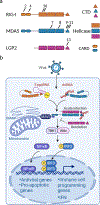RIG-I-like Receptor Regulation of Immune Cell Function and Therapeutic Implications
- PMID: 36130131
- PMCID: PMC9512390
- DOI: 10.4049/jimmunol.2200395
RIG-I-like Receptor Regulation of Immune Cell Function and Therapeutic Implications
Abstract
Retinoic acid-inducible gene I-like receptors (RLRs) are cytosolic RNA sensors critical for initiation of antiviral immunity. Activation of RLRs following RNA recognition leads to production of antiviral genes and IFNs for induction of broad antiviral immunity. Although the RLRs are ubiquitously expressed, much of our understanding of these molecules comes from their study in epithelial cells and fibroblasts. However, RLR activation is critical for induction of immune function and long-term protective immunity. Recent work has focused on the roles of RLRs in immune cells and their contribution to programming of effective immune responses. This new understanding of RLR function in immune cells and immune programming has led to the development of vaccines and therapeutics targeting the RLRs. This review covers recent advances in our understanding of the contribution of RLRs to immune cell function during infection and the emerging RLR-targeting strategies for induction of immunity against cancer and viral infection.
Copyright © 2022 by The American Association of Immunologists, Inc.
Figures


Similar articles
-
Activation of the RIG-I pathway during influenza vaccination enhances the germinal center reaction, promotes T follicular helper cell induction, and provides a dose-sparing effect and protective immunity.J Virol. 2014 Dec;88(24):13990-4001. doi: 10.1128/JVI.02273-14. Epub 2014 Sep 24. J Virol. 2014. PMID: 25253340 Free PMC article.
-
Regulation of antiviral innate immune signaling by stress-induced RNA granules.J Biochem. 2016 Mar;159(3):279-86. doi: 10.1093/jb/mvv122. Epub 2016 Jan 8. J Biochem. 2016. PMID: 26748340 Free PMC article. Review.
-
RIG-I-like receptors: Molecular mechanism of activation and signaling.Adv Immunol. 2023;158:1-74. doi: 10.1016/bs.ai.2023.03.001. Epub 2023 May 9. Adv Immunol. 2023. PMID: 37453753 Review.
-
Retinoic acid-inducible gene I (RIG-I)-like receptors (RLRs) in fish: current knowledge and future perspectives.Immunology. 2017 May;151(1):16-25. doi: 10.1111/imm.12714. Epub 2017 Feb 28. Immunology. 2017. PMID: 28109007 Free PMC article. Review.
-
A selective contribution of the RIG-I-like receptor pathway to type I interferon responses activated by cytosolic DNA.Proc Natl Acad Sci U S A. 2009 Oct 20;106(42):17870-5. doi: 10.1073/pnas.0909545106. Epub 2009 Oct 1. Proc Natl Acad Sci U S A. 2009. PMID: 19805092 Free PMC article.
Cited by
-
Novel RNA biomarkers improve discrimination of children with tuberculosis disease from those with non-TB pneumonia after in vitro stimulation.Front Immunol. 2024 Sep 26;15:1401647. doi: 10.3389/fimmu.2024.1401647. eCollection 2024. Front Immunol. 2024. PMID: 39391304 Free PMC article.
-
Immune metabolic restoration in systemic lupus erythematosus: the impact of gut microbiota, probiotics, and nutritional synergy.Front Immunol. 2025 Jun 4;16:1602235. doi: 10.3389/fimmu.2025.1602235. eCollection 2025. Front Immunol. 2025. PMID: 40534849 Free PMC article. Review.
-
New Insights into the Crosstalk among the Interferon and Inflammatory Signaling Pathways in Response to Viral Infections: Defense or Homeostasis.Viruses. 2022 Dec 15;14(12):2798. doi: 10.3390/v14122798. Viruses. 2022. PMID: 36560803 Free PMC article. Review.
-
Interaction of SARS-CoV-2 Nucleocapsid Protein and Human RNA Helicases DDX1 and DDX3X Modulates Their Activities on Double-Stranded RNA.Int J Mol Sci. 2023 Mar 17;24(6):5784. doi: 10.3390/ijms24065784. Int J Mol Sci. 2023. PMID: 36982856 Free PMC article.
-
Antifungal immunity: advances in PRR recognition, adaptive responses, and immune-based therapies.Sci China Life Sci. 2025 Aug;68(8):2206-2224. doi: 10.1007/s11427-024-2835-y. Epub 2025 Mar 5. Sci China Life Sci. 2025. PMID: 40055278 Review.
References
Publication types
MeSH terms
Substances
Grants and funding
LinkOut - more resources
Full Text Sources

